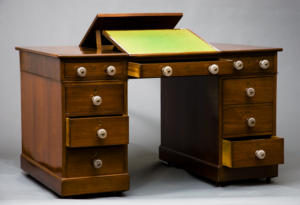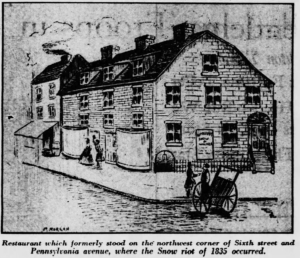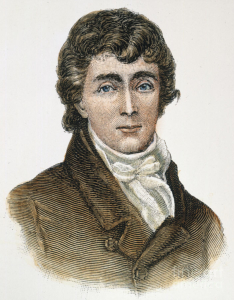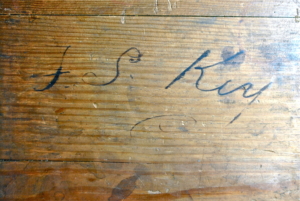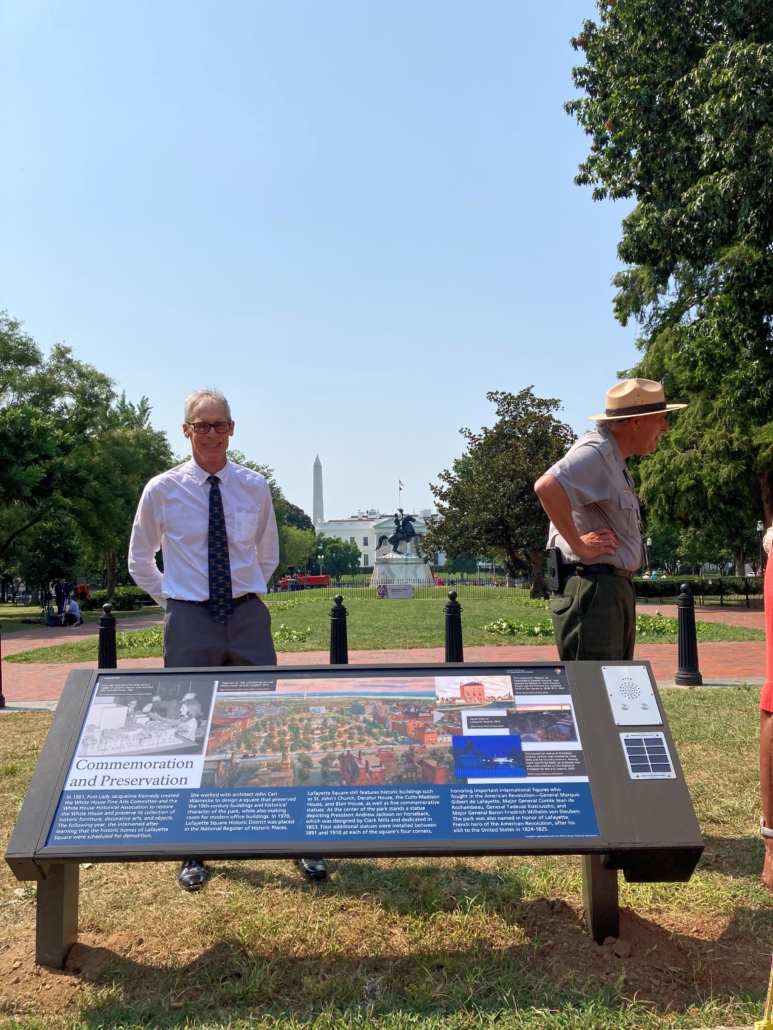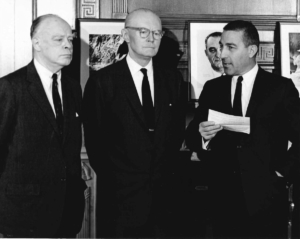By Tudor Place Archivist Wendy Kail
As with all historic events that have captured the public imagination, the story of the birth of the national anthem reflects that there is truth in legend and legend in truth. The gallant defense of Fort McHenry in Baltimore under the command of Lieutenant Colonel George Armistead (1780-1818) began on the morning of Tuesday, September 13, and lasted until the early morning of September 14, 1814. The British, fresh from their recent victorious invasion of the United States Capital, were confident and proud. By contrast, news of the poor showing by American troops, disarray in the President’s Cabinet and their contradictory orders to the officers in the field, and the embarrassing flight of President Madison had humiliated the American troops. Morale was low, and yet hope and determination were strongholds as the American force prepared for defense.
After the United States declared war on Great Britain on June 14, 1812, military operations centralized in the north. But in 1813 an enemy ship left Lynn Haven Bay, Virginia, and sailed into the Chesapeake. Chaos and fear gripped the people as the Patapsco River was blockaded, Annapolis and Baltimore threatened, Havre de Grace attacked and burned, and the small towns on the Eastern Shore of Maryland raided. On August 19, 1814 the British landed in Benedict, Charles County, and began a march to Nottingham, Maryland. The town of Nottingham offered the British little resistance, and the British followed the road along the Patuxent River to Upper Marlborough, which they entered August 22, 1814. British Major General Robert Ross (1766-1814) confiscated and set up his Head Quarters at the home of Dr. William Beanes (1749-1828), a local physician in Upper Marlborough. There on August 23 in council with Admiral of the Fleet Sir George Cockburn (1752-1853), it was decided that the army vacate the town and start south. Head Quarters was then transferred to Mellwood [Melwood Park], the old home of the second Governor of Maryland, Thomas Sim Lee (1745-1819).
General Ross was on his way to Washington. On August 24 American forces assembled at Bladensburg. Before 1:00 P.M. General Ross’ army began to fire. The Americans endured a terrible onslaught, and without support they gave way. By 4:00 P.M. that same day the British were victorious. Official Washington was warned, but remained indifferent. When the British did reach the nation’s capital, it was undefended. The British burned the Capitol, the President’s mansion, the Navy Yard barracks, and other public buildings except for the Patent Office. The nation’s capital endured the loss of two million dollars in destruction. 1
The triumphant Ross returned to Bladensburg on August 25. According to the courtesy of war, his wounded men were permitted to remain behind unscathed in enemy territory. Ross reached Upper Marlborough on August 26. He and his men encamped this time at The Wood Yard [Woodyard], home of Colonel Richard W. West. 2 Upon arrival there, soldiers were sent to the town and immediately placed Dr. William Beanes, their former host, under arrest. This was the first step that placed Francis Scott Key (1780-1843) in the precarious but advantageous position to author the “Star Spangled Banner.”
The earliest and perhaps most accurate account of the incidents that occurred on August 25 is revealed from an account written by the brother-in-law of Francis Scott Key, Chief Justice R.B. Taney (1777-1864) in 1857:
When, after the battle of Bladensburg, [Maryland], the main body of the British army passed through the town of Upper Marlborough, some stragglers, who had left the ranks to plunder or from some other motive, made their appearance from time to time, singly or in small squads, and a Doctor Beanes, who had previously been very hospitable to the British officers ‘put himself at the head of a small body of citizens to pursue and make prisoners’ of the stragglers. Information of this proceeding reached the British and Doctor Beanes was promptly seized. . . Doctor Beanes was the leading physician of his town and so highly respected that the news of his imprisonment filled his friends with alarm . . . they were informed that he had been carried as a prisoner on board the fleet. 3
Who was the man whose capture by the British started the chain-reaction of events that led to the writing of our national anthem? William Beanes, the son of William (d.1801) and Mary Bradley Beanes (d. 1794), was born January 24, 1749 at Brooke Ridge [near Croom, Maryland], Prince George’s County, on his father’s estate of 1,000 acres. He was a fourth generation American and the third Beanes to carry the name William. Little is known of his early days; there was no medical college in the United States at this time, but he studied medicine under the eye of an experienced practitioner. In 1773 he married Sarah Hawkins Hanson (ND), a niece of the President of the First Continental Congress, John Hanson (1721-1783). Dr. Beanes was a staunch patriot; when the First Continental Congress adopted a series of measures to counter the severe taxes levied by England at the colonies, he helped to carry these “Resolves” into effect in Prince George’s County. 4 When the government established the first medical hospital at Philadelphia, Dr. Beanes treated the wounded brought from Long Island, Brandywine, and Valley Forge.
He made his home in the town of Upper Marlborough at “Academy Hill” [present site of Marlborough High School], where he owned several farms and a gristmill, but continued to practice his profession to a growing number of patients. He was one of the founders and a member of the examining board of the Medical and Chirurgical Faculty of Maryland , where potential physicians were examined before being admitted to practice. 5 His quiet life was interrupted when Major General Robert Ross confiscated his home for Head Quarters. Dr. Beanes had co-operated with the British to the best of his ability. Yet when Ross returned to Upper Marlborough on August 26, he immediately placed Dr. William Beanes under arrest. As Chief Justice Taney described, Dr. Beanes was so highly respected that the news of his sudden imprisonment by the British filled his friends with alarm.
Several explanations for this rash deed have been offered. A pro-British version noted: Dr. Beames was celebrating a rumor that the British had been defeated at Washington. Therefore, when “three foot-sore, dusty, and weary soldiers made their appearance on the scene in quest of water,” under the influence of punch Dr. Beames and his friends made the three men prisoners of war, and “very naturally . . . the British resented this . . . indiscreet act.” 6
According to another source, when British marauders approached local citizens, Dr. Beanes and a small party of friends organized a group of men who arrested the marauders and threw them in jail. But one escaped their notice, and returned to Ross with the information. Ross ordered the arrest of three men, Dr. William Beanes, Dr. William Hill, and Philip Weems. Hill and Weems were immediately released, but General Ross and Rear Admiral George Cockburn refused to release Dr. Beanes. 7
A third account records that a party of British stragglers burst into the Doctor’s garden. The British flaunted their most recent victories and were “boisterous, disorderly, and insolent, and upon being ordered to leave the premises became threatening.” Dr. Beanes and his friends refused to be intimidated, however, and at their demand the men were arrested and placed in the Marlborough jail. 8
But perhaps most credible is the reasoning that when Dr. Beanes played host under duress to the British, he played his part too well. He must have thought that diplomacy was the best policy, for his home and property were protected by the British. Dr. Beanes, who had been a staunch patriot during the Revolutionary War, “carried his policy of diplomacy to such an extreme as to weave his own web of trouble.” 9 Whatever the circumstances concerning the imprisonment of British soldiers, General Ross and Admiral Cockburn evidently thought that Dr. Beanes was one of them when they had occupied his house as Head Quarters August 22 and 23. Throwing British soldiers into jail was a breach of faith that by British standards was insulting and unendurable; for this reason he was taken prisoner and treated cruelly not as a prisoner of war but as one “who had deceived and broken faith to them.” 10 According to legend, he was awakened in the middle of the night at gunpoint and then forced to accompany the British soldiers on horse-back for thirty-five miles to Benedict. The fine line between legend and truth here is difficult to determine and we may never know exactly what did happen, but Dr. Beanes was indeed taken prisoner and that act set the wheels in motion for the events which followed.
When Colonel Richard West of The Wood Yard learned that his friend the doctor had been placed under arrest by the British, he did not hesitate. He rode to Washington and persuaded another friend of the doctor’s, Francis Scott Key (1779-1853), to travel to Baltimore to obtain Beanes’ release. Key, a well-respected lawyer by profession and a resident of Georgetown, was a volunteer in Major George Peter’s (1779-1861) Light Artillery. Colonel West urged Key “to obtain the sanction of government to his going on board the admiral’s ship under a flag of truce and . . . procure the release of Dr. Beanes, before the fleet sailed.” 11
As Colonel West had hoped, Francis Scott Key took action. He immediately agreed to take on the task of his friend’s release. He sent his family for safety to his father’s estate “Terra Ruba,” [Frederick County, Maryland]. Key approached President Madison who, to his credit, sanctioned the effort. The vessel The Minden was issued as a cartel in the communication with the fleet in the Chesapeake Bay, and John Stuart Skinner (1788-1851), United States Agent for the Parol[e] of Prisoners, representative of the government for flags of truce and exchange of prisoners and a man well known to the officers of the fleet, was chosen to accompany Key. 12 A letter dated August 31, 1814 of protest from the American General William Henry Winder (1775-1824) to General Ross alluding, to great rudeness and indignity heaped upon a respectable and aged old man . . .” was to no avail; Dr. Beanes was not set free.
Key and Skinner hurried to Baltimore on the morning of September 5. They found the British fleet at the mouth of the Potomac River, where they were preparing for an attack on Baltimore. Key and Skinner were politely received by Vice Admiral Alexander Cochrane (1758-1832) and the officers of the ship. But when they explained the reason for their visit, General Ross and most particularly Admiral Cockburn, who had led the raid on Washington and was known as “The Red Devil of the Chesapeake,” received the request coldly. 13 Quite luckily, however, Mr. Skinner had thought to obtain and carry with him letters from the wounded British officers who had been left behind at Bladensburg. These letters spoke of the kindness with which they had been treated by the Americans.
After a good deal of negotiation as to the character and high standing of Dr. Beanes and the anxious interest of his fate in his community, General Ross observed that Dr. Beanes deserved more punishment than he had received, but that he felt bound to return the kindness which had been shown to his wounded men. On that ground, and only on that ground, he would release Dr. Beanes. But despite the sigh of relief Key and Skinner must have shared at that moment, they were told that no one would be allowed to leave the fleet for some days, as the attack on Baltimore was imminent. Francis Scott Key, John Stuart Skinner, and Dr. Beanes were deterred to the frigate The Surprise, commanded by Cochrane’s son Admiral Thomas Cochrane (1775-1860).
Key requested an interview with Dr. Beanes. He was shocked to see that the doctor had not had a change of clothes since his seizure in the middle of the night, and to learn that he had not been treated with military courtesy as a prisoner of war, but as a common culprit whom no officer would address. Through Key’s and Skinner’s efforts the doctor was transferred to The Surprise with them, and found the Admiral’s son to be a kind host.
The fleet reached the Patapsco River and the British troops prepared to land. On September 10 Key and Skinner and the doctor were returned to The Minden with a guard of sailors. They were anchored in a perfect position from the deck of their own vessel to see the ensign of their country flying over the fort. The bombardment commenced on September 13. Key and Skinner spent the long night observing the enemy’s attacks. Strangely enough, the continual sound of bombs exploding was a positive sound, for it proved that the fort had not surrendered. When silence suddenly engulfed them early the next morning of the 14th, the men did not know if the fort had fallen or if the British had abandoned the attack. But dawn broke and scattered enough light to allow them to observe the flag of their country, and they knew that the American cause had endured. Key hurriedly scribbled words on the back of a letter he had in his pocket. 14 When asked to describe the conditions under which he wrote the words, Key stated that he
. . . commenced it on the deck of their vessel, in the fervor of the moment, when he saw the enemy hastily retreating to their ships, and looked at the flag he had watched for so anxiously as the morning opened; that he had written some lines, or brief notes that would aid him in calling them to mind, upon the back of a letter which he happened to have in his pocket; and for some of the lines, as he proceeded, he was obliged to rely altogether on his memory; and that he finished it in the boat on his way to the shore, and wrote it out as it now stands, at the hotel on the night he reached Baltimore, and immediately after he arrived. . . 15
The remainder of the story of the birth of our national anthem is a barrage of fact and fiction. Whether Key wrote the words that filled his heart with or without the melody of “To Anacreon in Heaven” as a structural basis is not known and has been hotly debated by scholars. “To Anacreon in Heaven,” written in 1771/3 by John Stafford Smith (1750-1836), was sung traditionally by the Anacreontic Society, an exclusive musical club in London. Rumor was that the song was usually sung by the presiding officer of the club on important occasions, while other members joined in as a chorus. 16 But the tune was popular, very common at the time of the bombardment of Fort McHenry, and as the saying goes, “in the air.” It had crossed the ocean and everyone was singing it. One soldier recalled:
. . . during the attack on Fort McHenry, Sept., 1814, there was a very popular and fashionable new song in vogue, viz: “To Anacreon in Heaven,” every one [sic] who could sing seemed to be singing it. [I was] . . . (Sept. 1814) one of some three or four thousand men comprising the advance Light Brigade, chiefly volunteers from Philadelphia . . . encamped in the state of Delaware. In the evenings before tattoo, many of the men would assemble and sing this song, hundreds joining in the chorus. Mr. Key must have caught the infection and adopted his words to the same air. 17
There has been great debate about who first sang the words Key put to song, and where it was sung. Several autographed copies tended to confuse the issue of which was the original, and even more confusion arose with slight variations in the wording of the secondary stanzas. There also has been criticism that the remaining three stanzas are overshadowed by the first; there has been debate about the value of these largely ignored stanzas. This particular criticism seems to surface especially at wartime, when patriotism runs rampant. It has even been argued that the citizens of this country did not know the words to the secondary verses, which were too complicated and obscure for a national anthem. As late as 1947 while the memory of World War II was strong in the minds of our collective memory, a speaker recalled that such criticism also arose from 1920 to 1930 in the aftermath of World War I:
From the war zone came the story of a sentry who, on hearing a noise at night, shouted: “Halt! Who goes there?” The voice said: “An American.” “Advance,” commanded the sentry, “and give the second verse of The Star-Spangled Banner.” “I don’t know it,” said the voice in the darkness; whereupon the sentry said: “Proceed, American.” 18
But those in favor of the anthem argue, does not the value of the first stanza outweigh these faults, if these are faults at all? Key was first and foremost a lawyer, not a poet.
The truth is that none of these objections matter very much. What does matter is that Francis Scott Key was “an instrument in the hands of destiny.” Drawn without hesitation by loyalty to a steep and dangerous precipice, Key responded as we all wish to respond, for “It is through sentiment, the emotions, that we are bound together . . . ” 19 Key captured for all time the thrilling moment in which the stars in the sky, the future, and the stars on our flag, the present, were magnificently and perfectly aligned. The tide was turning in favor of the American cause.
Tudor Place is proud to hold an early edition of [The]”Star Spangled Banner.” Philadelphia: Published by A. Bacon & Co. S. 4th St. [1814-1816] [Fifth Edition], 4 pp., pp.1 and 4 blank. 20 Many editions of this song have been printed. There are eight copies of the first edition known to exist. The first publication in any form under the title of “The Star Spangled Banner,” previously a poem known as Defence of Fort M’Henry, was published in Baltimore and sold at J[oseph] Carrs Music Store, 36 Baltimore Street [1814] [First Edition]. The principal identification of this edition is the misspelling of the word “Pa[t]riotic” in the caption title: “A Pariotic (sic) Song. Air. Anacreon in Heaven. 4 pp., pp. 1 and 4 blank.” In the lower margins of pages 2 and 3 is the notation “(Adapd. & Arrd. by T.C. [Thomas Carr]).”
We are fortunate to have a fifth edition ca.1814-1816 published in Philadelphia by A[llyn] Bacon & Co., 11 South 4th Street. This particular edition is identified by the presence of the American flag with twelve visible stars engraved under the title on page 2. This same edition was republished at a later date with the notation “Price, 25 Cts.” included in the descriptive title and the Plate Mark 17 in the lower margins of pages 2 and 3. 21
Four other songs had been written earlier than the “Star Spangled Banner” to the melody of “To Anacreon in Heaven.” These included: “Freedom Triumphant,” published by B. Carr, New York and Philadelphia, 1796; “Adams and Liberty,” published by Thomas & Andrews, Boston, 1798; “The Pillar of Glory,” published by G.E. Blake, Philadelphia, ca. 1814; and “When Death’s Gloomy Angel Was Bending His Bow”, G. Willig, Philadelphia, ca. 1814. 22 Key had written an earlier poem entitled “The Warrior’s Return” to commemorate Commodore Stephen Decatur’s (1779-1820) triumphant return from the War with Tripoli (1801-1805) to this same tune. But none of these early songs endured as did Key’s War of 1812 rendition, which was adopted as the national anthem of the United States under the aegis of President Herbert Hoover on March 3, 1931.
Epilogue
After his release from imprisonment, Dr. Beanes returned to his home on Academy Hill in Upper Marlborough, [Prince George’s County, Maryland]. His life returned to normal as the last months of the war officially drew to a close. By Thursday, October 27, 1814, he was bold enough to advertise in the Daily National Intelligencer and offered a reward of $30 “. . . for black mare taken from my plantation by the British, on Aug. 22, also 1 gray mare & 3 mules.” 23 The war with England officially ended on Christmas Eve, December 24, 1814, with the signing of the Treaty of Ghent. The Doctor resumed his practice and was loved and respected by his patients and friends, who remembered him as “. . . a very prominent physician, who used to ride around the neighborhood . . . a century ago with his coach-and-four.” 24
Footnotes
1 Caleb C. Magruder, Jr., “The Incidental Cause of the Authorship of the Star-Spangled Banner.” Records of The Columbia Historical Society. Volume 22 (Washington, D.C.: The Columbia Historical Society, 1919), 216. [back]
2 Allen C. Clark, “George Gordon of the Two Original Proprietors of George Town, D.C.” Records of The Columbia Historical Society. Volume 42-43 (Washington, D.C.: The Columbia Historical Society, 1942), 250-251. Clark quotes a description of The Wood Yard by Miss Elizabeth Duhamel: “The house was built in the shape of an L with forty rooms and seventy-two windows. The lawn was shaded by large forest trees and on each side of the general walk leading to the house were box trees so tall and broad as to conceal a carriage and pair. In 1868 this ancestral home was destroyed by fire . . .” The home of Colonel Richard W. West had been the site of Henry Darnall’s (1645-1711) early 18th century mansion “Darnall’s Delight.” [back]
3 Oscar George Theodore Sonneck, Report on “The Star-Spangled Banner,” “Hail Columbia,” “America,” & “Yankee Doodle” (New York: Dover Publications, Inc., 1972, reprint), 8. [back]
5 Ibid., 210. Chirurgical is defined as: Belonging to surgery; relating to the manual part of healing. [back]
6 Sonneck, 11. According to Sonneck this version of the imprisonment of Dr. Beanes is attributed to Mrs. Anna H. Dorsey, was first published in the Washington Sunday Morning Chronicle (ND) and then reprinted: Anna Hanson Dorsey, “Origin of the Star-Spangled Banner.” The Historical Magazine. Volume 5 (New York: Richardson & Co., 1861), 282-283. [back]
8 Sonneck, 11. This account is credited to Mr. F.S. Key Smith in the Republic Magazine, April, 1908, pp. 10-20, in an article titled “Fort McHenry and ‘The Star-Spangled Banner.’” [back]
12 F.S.Key Smith,”A Sketch of Francis Scott Key, with a Glimpse of his Ancestors.” Records of The Columbia Historical Society. Volume 12 (Washington, D.C.: The Columbia Historical Society, 1909), 83. [back]
13 Ella Loraine Dorsey, “A Biographical Sketch of James Maccubbin Lingan, one of the Original Proprietors.” Records of The Columbia Historical Society. Volume 46-47 (Washington, D.C.: The Columbia Historical Society, 1910), 9. [back]
15 Ibid., 10. [back]
16 Edward S. Delaplaine, “Francis Scott Key and the National Anthem.” Records of The Columbia Historical Society. Volume 46-47 (Washington, D.C.: The Columbia Historical Society, 1947), 22. [back]
17 Sonneck, 26. Mr. Charles V. Hagner wrote these words in a letter dated January 28, 1873 [Philadelphia], to The American Historical Record, Volume 2, 1873, page 129. [back]
20 Tudor Place Historic House & Garden Archive, Gifts and Purchases, MS 25. This sheet music is bound in the music book of Susan E. Smith and was a gift of the Massie family in 1993. [back]
21 Harry Dichter and Elliott Shapiro, Handbook of Early American Sheet Music 1768-1889 (New York: Dover Publications, Inc., 1977, reprint), 37. [back]
22 Dichter and Shapiro, 35. [back]
23 Joan M. Dixon, National Intelligencer & Washingon Advertiser Newspaper Abstracts 1814-1817 (Bowie, Maryland: Heritage Books, 1997), 62. [back]
24 Robert H. Harkness, “Dr. William Magruder.” Records of The Columbia Historical Society. Volume 16 (Washington, D.C.: The Columbia Historical Society, 1913), 151. [back]
Bibliography
Clark, Allen C. “George Gordon of the Two Original Proprietors of George Town, D.C.” Records of the Columbia Historical Society. Volume 42-43. Washington, D.C.: Published by the Society, 1942, pp. 243-252.
Delaplaine, Edward S. “Francis Scott Key and the National Anthem.” Records of The Columbia Historical Society. Volume 46-47. Washington, D.C.: The Columbia Historical Society, 1947, pp. 13-26.
Dichter, Harry and Elliott Shapiro. Handbook of Early American Sheet Music 1768-1889. New York: R.R. Bowker Company, 1941; reprint ed., New York: Dover Publications, Inc., 1977.
Dixon, Joan M. National Intelligencer & Washingon Advertiser Newspaper Abstracts 1814-1817. Bowie, Maryland: Heritage Books, 1997.
Dorsey, Ella Loraine. “A Biographical Sketch of James Maccubbin Lingan, One of the Original Proprietors.” Records of The Columbia Historical Society. Volume 46-47. Washington, D.C.: The Columbia Historical Society, 1910, pp. 1-48.
Harkness, Robert H. “Dr. William Magruder.” Records of The Columbia Historical Society. Volume 16. Washington, D.C.: The Columbia Historical Society, 1913, pp.150-189.
Magruder, Caleb C., Jr. “The Incidental Cause of the Authorship of the Star-Spangled Banner.” Records of The Columbia Historical Society. Volume 22. Washington, D.C.: The Columbia Historical Society, 1919, pp. 207-227.
Smith, F.S. Key. “A Sketch of Francis Scott Key, with a Glimpse of his Ancestors.” Records of The Columbia Historical Society. Volume 12. Washington, D.C.: The Columbia Historical Society, 1909, pp. 71-88.
Sonneck, Oscar George Theodore. Report on “The Star-Spangled Banner,” “Hail Columbia,” “America,” & “Yankee Doodle.” Washington, D.C.: Government Printing Office, 1909; reprint ed., New York: Dover Publications, Inc., 1972.
Archive
Tudor Place Historic House & Garden, Washington, District of Columbia
